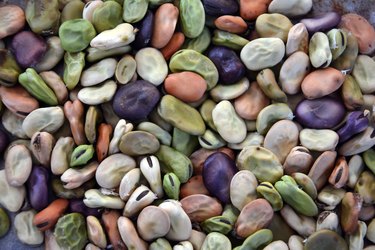
It's a good idea to incorporate lots of fiber into your diet to reduce the risk of heart disease, stroke, type 2 diabetes and bowel cancer. Getting fiber from a variety of foods is best because eating too much from one source might not give you all the benefits of a healthy balanced diet. Many Americans do not get enough fiber the average adult only eats 15 grams of fiber per day according to the Harvard School of Public Health. This is well below the daily recommended amount needed for optimal health recommended by Dietary Reference Intakes.
What Is Roughage?
Video of the Day
Roughage, also known as fiber or bulk, is a fibrous indigestible compound that your body can't absorb. It aids in the passage of food and waste products through the gut. Fiber is usually associated with bowel regularity, intestinal disorders and decreased risk of developing diverticulitis, but roughage is beneficial to overall health as well. Fiber is found in many fruits, vegetables, grains and legumes, nuts and seeds.
Video of the Day
Fiber in Whole Grains
The fiber found in whole grains is generally insoluble, or does not dissolve in water, and adds water and bulk to stools. Consequently eating whole grains is an excellent way to treat chronic constipation and alleviate the discomfort of diverticulitis. Finding whole grains isn't difficult; just read the nutrition facts on the back of cereals, breads and pasta at the grocery store. For instance, USDA Branded Food Products Database says that whole-wheat pasta contains about 6 grams of dietary fiber. That's more than a fourth of your daily minimum requirement, which is 25 grams per day for women; 38 grams for men, according to Food and Nutrition Board, Institute of Medicine. For optimum benefits from fiber, choose whole-wheat bread that contains 2 grams or more of fiber.
Fiber in Legumes
Beans are a naturally high-fiber food and should be a staple in your diet. Legumes are a source of soluble fiber, or fiber that dissolves in water. Soluble fiber has been associated with significant decreases in unhealthy cholesterol and is good for protecting your heart health. And, the fiber in beans makes them filling, helpful for weight control. Add beans to soups, casseroles and salads for easy added fiber. For even greater health benefits, replace red meat with legumes. Beans may be beneficial in lowering your risk of breast cancer, according to a 2018 study published in Cancer Medicine. From the findings from 2,135 breast cancer cases, the conclusion verified that fiber-rich foods, such as beans, may lower the risk of aggressive breast cancer.
Read More: What Is the Healthiest Bean to Eat?
Fruits and Vegetables
Fruits and vegetables are not only high in roughage but also contain natural vitamins, minerals and nutrients, such as vitamin A and vitamin C. Raw fruits and vegetables are the best source of fiber, so try to make salads part of your everyday diet. Fruits with the highest fiber content include: pears, with 6 grams of dietary fiber and supplying 24 percent of your daily value; kiwi fruit, with 4 grams of fiber and meeting 16 percent DV; and apples with 5 grams of fiber and meeting 20 percent DV, says the FDA Food Guidance Regulations. Vegetables are also a top choice for adding fiber to your diet. And there is the added benefit that most vegetables don't contain significant amounts of saturated fat, trans fat or cholesterol. Some vegetable that offer the highest dietary fiber content are sweet potatoes, broccoli and green snap beans. It is a good idea to avoid canned fruits and vegetables, because they are high in sugar and salt and may have less nutrients because of the canning process.
Read More: Fruits and Vegetables
Nuts and Seeds
A nut is simply dry fruit with the seeds inside. There are many types of nuts including almonds, pecans, walnuts, brazil nuts, cashew nuts, chestnuts, hazelnuts, macadamia nuts, pine nuts and pistachio nuts. Some common varieties of seeds include sunflower, pumpkin, poppy, sesame chia, flaxseed and caraway that are considered roughage.
A one-ounce serving of nuts or seeds, roughly equal to a handful, provides 9 to 39 percent of the DV for fiber, which is 25 grams per day, according to MyFoodData. Chestnuts offer more fiber than most nuts with 4 grams in 10 nuts, supplying 17 percent DV. Examples of fiber content in other nuts include: almonds, with 3.5 grams of fiber per ounce, and sunflower seeds, with 3.9 grams of fiber per quarter-cup. Chia seed contributes a whopping 39 percent of DV for fiber per ounce.
Read More: Nuts and Seeds
- Harvard School of Public Health: Fiber
- Food and Nutrition Board, Institute of Medicine: Dietary Reference Intakes
- USDA Branded Food Products Database: Whole Wheat Pasta
- Livestrong.com: What Is the Healthiest Bean to Eat?
- Livestrong.com: What Are the Benefits of Soluble Fiber?
- FDA: Food Guidance Regulations: Fruit
- Livestrong.com: Fruits and Vegetables
- Livestrong.com: 19 High-Fiber Foods — Some May Surprise You!
- Livestrong.com: Nuts and Seeds
- MyFoodData: Top 10 Nuts and Seeds Highest in Fiber
- Livestrong.com: Legumes List